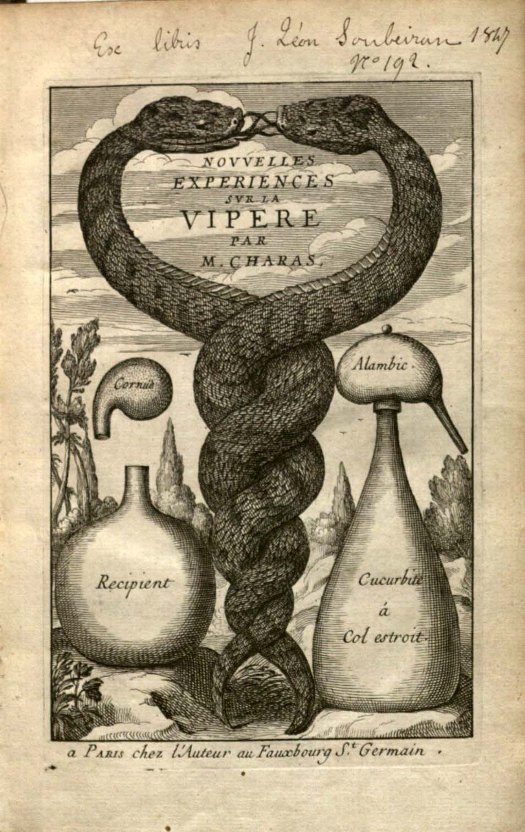October 18th, 2013 Sir Joseph Fayrer’s account of the Thanatophidia is important as a classic, systematic account of the venomous snakes of India. This second edition (the first was in 1872) was improved with the addition of text, even though the 31 lithographs (including 28 chromolithos) are identical in both editions.
Fayrer conducted extensive studies of the poison apparatus in Indian snakes and was responsible for many advances in the treatment of snakebite, including the use of potassium permanganate, of which he was the originator.

Above: Plate 8 (Ophiophagus Elaps) from Joseph Fayrer’s The Thanatophidia of India, second edition. London: J. and A. Churchill, 1874. Call Number: H199. Click image to enlarge.
The venomous snakes, and by extension all snakes, get a bad rap for what is primarily an extremely efficient food-getting mechanism, only secondarily defensive. Unless they are themselves attached, they kill other animals only for food. How else to get supper without either arms or legs? For a snake, there’s constriction or there’s fangs, although the spitting cobras of Africa send their poison by air-mail, blinding their victim. There is some question among herpetologists about whether the black mamba (the largest venomous snake in Africa) or the cobra, shown here in a very striking pose, will actually attack a human. Most snakes will try to escape a predator. In the United States, some species, such as the cottonmouth, will stand their ground and strike if the unwary come to close.
Sally Haines
Rare Books Cataloger
Adapted from her Spencer Research Library exhibit and catalog, Slithy Toves: Illustrated Classic Herpetological Books at the University of Kansas in Pictures and Conservations
Tags: Joseph Fayrer, poison, Sally Haines, Slithy Toves, snakes, Thanatophidia of India, zoological illustration
Posted in Exhibitions, Special Collections |
No Comments Yet »
October 5th, 2012 In his book on the viper, Nouvelles experiences sur la vipere, Parisian apothecary Moyse (or Moïse) Charas takes to task Italian physician, naturalist, and poet Francesco Redi (1626-1697), for his scientific study of viper bites, the first such research ever. Charas was of the opinion (and not alone in it) that venom per se was harmless and that death was caused by poisonous spirits injected into the victim by the mind of an infuriated viper. Charas’s title-page shows two vipers entwined as in the caduceus, or staff of Mercury, one of the symbols of the medical profession. The Aesculapian staff, after the Greco-Roman God of medicine and healing, Aesculapius, is branched at the top with a single snake twined around it; it is the official insignia of the American Medical Association.

Charas, Moyse (1618-1698). Nouvelles experiences sur la vipere.
A Paris: chez l’auteur et Olivier de Varennes, 1669. Ellis Omnia B30.
Click image to enlarge.
Charas recommended viper as a staple of the diet and as a preventive and cure for a good many diseases. His 17th century compatriot and contemporary Pierre Pomet (1658-1699) recommended distilled salts of viper to prevent measles, smallpox, plague, and scurvy, and to cure gout, rheumatisum, and venereal disease. Viper heart was prescribed for mealcholia. In another book, Trakat über den Theriak, Charas extols theriac, an anti-leprosy medicine made from powdered snake and used since antiquity; in medieval Europe the powder was formed into tablets, stamped with a snake image, and used against the bubonic plague. But that ain’t nothin’; our American frontiersmen gladly bought greasy-kid-stuff from snake-oil salesmen who took their money and swore the oil would grow hair back on their heads and cure the goiter to boot.
On the added engraved title-page of the Spencer Library’s copy (pictured above) is the inscription of the book’s former owner, French pharmacist and botanist Jean Leon Soubeiran (1827-1892). Soubeiran was the author of books on materia medica from all the kingdoms of nature–plant, animal, and mineral–including one on the venom of poisonous snakes.
Sally Haines
Rare Books Cataloger
Adapted from her Spencer Research Library exhibit and catalog, Slithy Toves: Illustrated Classic Herpetological Books at the University of Kansas in Pictures and Conservations.
Tags: history of science, Jean Leon Soubeiran, Moyse Charas, natural history, Nouvelles experiences sur la vipere, Sally Haines, snakes, Vipers
Posted in Exhibitions, Special Collections |
No Comments Yet »


